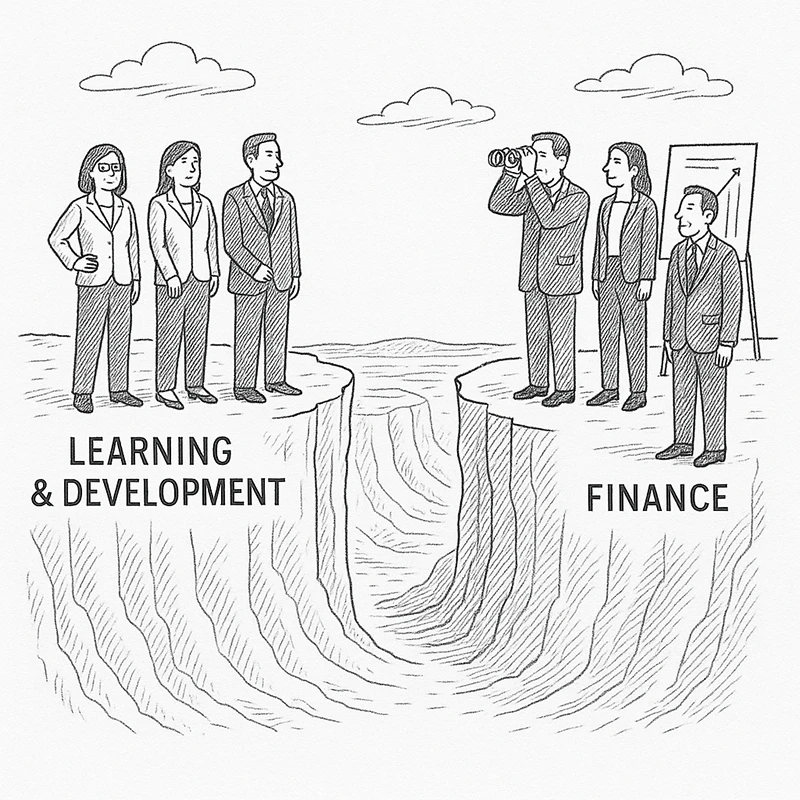October 28, 2025
5 Min. Read

Learning and Development leaders are some of the most optimistic people I have had the pleasure to work with. They believe deeply in boundless human potential and in the power of L&D to change a company’s trajectory.
So why doesn’t the business view L&D that same way? The answer is clear, and so is the opportunity.
Despite decades of investment, L&D still faces a stubborn perception problem. When I joined Schoox as Chief Financial Officer four years ago, I quickly discovered a glaring chasm: on one side, L&D leaders stand firm on the impact they’re making; on the other, financial leaders are scanning the horizon for proof.

It’s frustrating, because this perception is pervasive. It persists across industries, business sizes and regions.
Companies worldwide spend nearly $400 billion each year on learning and development. Yet surveys report that only 8% of CEOs say they see the investment as a driver of business performance. And for most CFOs, it remains a cost center: a line item that’s difficult, if not impossible, to quantify the ROI of.
The disconnect isn’t about belief. I haven’t met a single CEO or CFO who doesn’t believe that investing in people is the right thing to do. But I’ve met plenty who wonder whether the investments they’re making in people are actually working.
Ask the average CEO or CFO if their learning program is performing, and the answer will likely be: I don’t know.
For finance leaders, “I don’t know” is one of the most uncomfortable answers imaginable. We live by cause and effect: make an investment, prove the return. When we can’t see that link, questions follow. And that’s where most L&D programs lose their credibility.
It also means that L&D has an uncomfortable reputation in the business. Learning is defined by what it costs, not what it delivers.
This is where I see a clear opportunity.
How L&D Wins a Seat at the Table
L&D leaders have a chance to meet the C-suite halfway, starting by adopting the language and metrics that matter to their financial counterparts. That means moving beyond ‘check the box’ metrics like course completion rates or participation numbers and toward evidence of business outcomes.
This won’t happen overnight. But it can start with a single example of proof.
Imagine an L&D leader at a restaurant chain saying: “We piloted a new learning program at our largest north Georgia location. Employee retention rose 30%, and store revenue grew 10%.” That’s the kind of statement that gets a CFO’s attention.
Of course, getting to that point takes more than enthusiasm. It requires three things: the right leaders, the right tools, and the right communication strategy.
Leaders: L&D leaders already have the passion and vision to drive real impact. What they need now is the right toolbox and communication strategy to quantify outcomes in ways that resonate with the business.
Solutions: Current L&D platforms fall short of connecting learning directly to business performance. The next generation of solutions must provide evidence that their training develops the right skills to impact the business and dashboards that directly tie learning initiatives to metrics like revenue per store, customer satisfaction, and upsell rates. The best platforms will incorporate company data like financials, KPIs and brand strategy to dynamically integrate skills training that will fill business gaps.
Communication strategy: Finally, L&D teams must close the loop. This is where the right external partner takes them to the next level. To do more than saddle leaders with daunting course libraries, they should equip leaders to translate learning outcomes into business language and take an active role in L&D’s preparedness to share results with the C-suite.
If Learning’s Devalued, The Business Pays the Price
There is real financial risk if we continue to treat L&D as a cost center. It quietly devalues people and their role in making a difference in organizations. The devaluation of people often ripples across the business. Organizations will not stay competitive if they don’t continually adapt their skills at the pace of business change.
According to Gallup, employee disengagement cost companies around the world $8.8 trillion in lost productivity. And U.S. businesses spent more than $1 billion per week on workplace injuries alone in 2021, according to a recent safety index.
If companies don’t invest in learning, they also send a signal that people are expendable. In an era defined by AI and automation, that mindset is dangerous.
Meanwhile, humans are still the frontline of most businesses. A customer’s experience is defined by the person they interact with at the cash register, in the store, or in the field. Every transaction, every service interaction, every moment of trust between a brand and its customer starts with a person.
Undervaluing investment in people erodes the quality of the business itself.
We have an opportunity to prevent this now, not later. If learning leaders start speaking finance’s language with the help of powerful tools and partners, something special happens: learning sheds its reputation of being a black box and starts becoming an integral element of business strategy.
That’s the future of L&D. Where optimism and belief meet proof.



